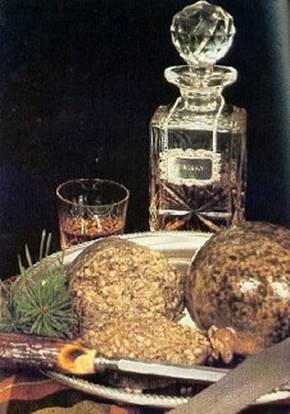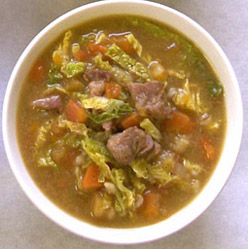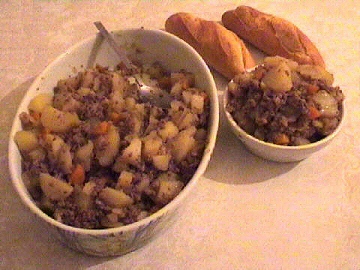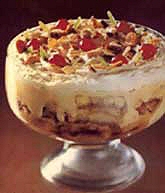National Food and Drink of Scotland
1. Haggis
2. Whisky
3. Other Dishes

![]() It's something
like májashurka)
It's something
like májashurka)
Ingredients
1
sheep's stomach bag plus the pluck (lights, liver and heart)
1 lb
Lean Lamb
6 oz
Oatmeal
8 oz
Shredded Suet
2
large Onions, chopped
about
1/4 pint beef stock
How to make it
-
Soak the stomach bag in salted water overnight.
-
Place the pluck (lights, liver and heart) in a saucepan with the windpipe hanging over the edge. Cover with water and boil for up to 2 hours. Impurities will pass out through the windpipe and so you need to put a basin under it to catch any drips. Drain well and cool. Remove the windpipe and any gristle or skin..
-
Mince the liver and heart with the lamb. (Add some of the lights before mincing if you wish.)
-
Toast the oatmeal gently until crisp and pale golden brown.
-
Combine the suet and onion with minced mixture. Season well and add enough stock to moisten well. Pack it all into the stomach bag, filling it just over half-full as the stuffing will swell during cooking.
-
Tie the bag tightly with a string. Prick the haggis all over with a needle to stop it bursting as it swells
-
Put an upturned plate in the base of a saucepan of boiling water, stand the haggis on this and bring to the boil, and let it boil slowly for about 4 hours.
-
Makes enough for 6 to 8 helpings of delicious haggis.
...
is distilled from a barley or
grain liquor and flavoured with peat tainted water. Known as the ‘Water of
Life’ or ‘Uisge-Beatha’
in Gaelic. There are two sorts of whisky:
-
Malt Whisky - made from barley, more expensive, and the product of a single distillery.
-
Blended Whisky - made by blending grain and malt whisky and is, therefore, cheaper
The whisky-producing areas of
Ingredients
Grain:
Malt Whisky only uses
barley. Strangely the barley does not necessarily have to be
from
Water:
Distilleries need a lot of water, and often there is not enough, and they have
to stop working. Water is used for the production of wort,
the wash, as a coolant and to dilute the product before bottling.
Peat:
After germination, the grain is traditionally dried
over a peat fire. The heat and smoke from the peat fire rises up through
holes in the drying floor. After being dried in this way, the grain is called
"malt"
and is ready to be ground in a mill (after which it is called
grist).
Yeast:
The grist it is mixed with water and yeast in the washback. The liquid is called
wash
at this stage and is basically a kind of beer, albeit a very strong one (up
till now, the production is very similar to that of normal beer).
Wood:
The casks that the whisky matures in for many years
are very important. Sometimes used bourbon or sherry casks are employed for
ageing because they impart their own special flavour to the whisky. For scotch
malt whisky, nothing else but oak casks will do.
The Method
-
The grain is left in water to germinate
-
It is dried over peat fires to make the malt
-
The malt is milled to make grist
-
The grist is mixed with hot water, cooled and filtered to make wort
-
Yeast is added to the wort to make the wash
-
The wash is distilled twice in potstills
-
The final distillate, the raw malt whisky, is colourless and high in alcohol.
-
Whisky is usually about 70% alcohol by volume when distilled
-
The raw whisky is filled into oak casks and aged (The longer a whisky remains in cask, the more flavour it will acquire). This mellows the malt and gives it colour
-
Before bottling it is diluted to around 40%
Other Dishes
|
|
Scotch Broth:
A rich soup with a
meat stock base, diced vegetables and barley. Served thick and hot |
|
|
Tatties (or Stovies):
Stovies were invented to use
up left over meat and vegetables in a mainly potato dish. Leftover meat and
vegetables are fried with onions, then cooked in a little water with potato
pieces till the potatoes are soft. They have almost the consistency of mashed
potatoes, but you can still detect the lumps! |
|
|
Atholl Brose: a pudding from cream and drambuie
Drambuie (dram 'boo ee or
dram
'byoo ee) is a honey and herb flavoured golden scotch whisky liqueur made
from aged malt whisky, heather honey and a secret blend of herbs and spices. |
|
|
Tipsy
Laird:
a Scottish trifle with drambuie |



